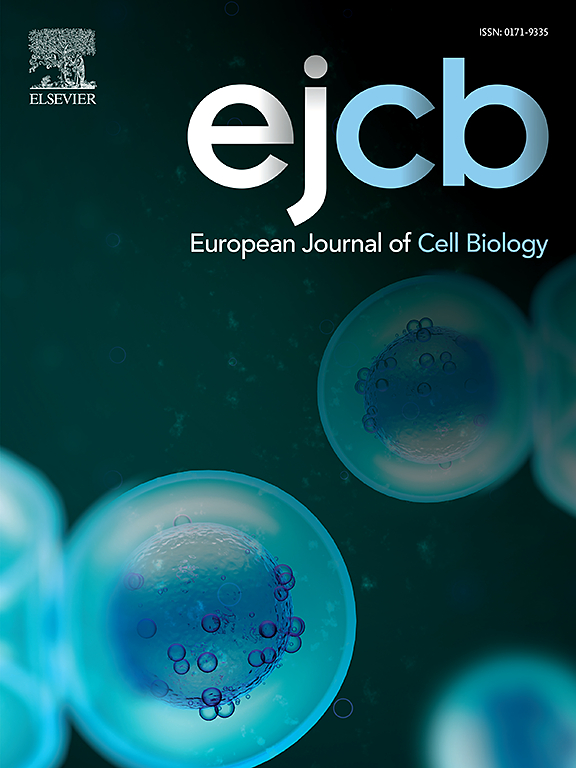小细胞肺癌进展过程中的 mTOR 活性和 RICTOR 拷贝数增加。
IF 4.3
3区 生物学
Q2 CELL BIOLOGY
引用次数: 0
摘要
小细胞肺癌(SCLC)是一种高度恶性的癌症,具有早期转移扩散和临床预后差的特点。磷脂酰肌醇3-激酶(PI3K)/蛋白激酶B(Akt)/哺乳动物雷帕霉素靶蛋白(mTOR)通路中的突变,包括经常出现的雷帕霉素不敏感蛋白(RICTOR)扩增,已在这些肿瘤中得到描述。此外,相关的mTOR活性亢进可用于个性化治疗。我们的目的是研究mTOR活性、RICTOR扩增及其在SCLC进展过程中的作用。我们采用免疫组化方法对 50 例原发性肿瘤、50 例脑转移瘤和 14 例配对的 SCLC 患者样本进行了原位 mTOR 活性和 RICTOR 表达定性。通过对配对的 SCLC 患者样本进行荧光原位杂交和体内实验,分析了 RICTOR 的拷贝数变化。此外,还评估了携带 RICTOR 扩增和其他 mTOR 通路突变的 SCLC 细胞系对顺铂和 mTOR 抑制剂的体外敏感性。RICTOR的高表达和mTOR复合物2(mTORC2)的亢进与脑转移和总生存期的恶化密切相关。在进展过程中,配对样本中观察到RICTOR拷贝数的增加。vistusertib在体外的增敏作用和异种移植物中RICTOR拷贝数/表达的变化都证实了这些改变的重要性。我们的研究强调了mTORC2在SCLC进展中的作用。早期检测原发性肿瘤中的RICTOR扩增,并在这些病例中以mTORC2为靶点,可能是开发预防转移的个性化疗法的一种前景广阔的新策略。本文章由计算机程序翻译,如有差异,请以英文原文为准。
Increased mTOR activity and RICTOR copy number in small cell lung carcinoma progression
Small cell lung carcinoma (SCLC) is a highly malignant cancer with early metastatic dissemination and poor clinical outcomes. Mutations in the phosphatidylinositol 3-kinase (PI3K)/protein kinase B (Akt)/mammalian target of rapamycin (mTOR) pathway, including the frequently occurring rapamycin-insensitive protein (RICTOR) amplification, have been described in these tumours. Moreover, the associated mTOR hyperactivity could be exploited for personalised treatment. Our aim was to study mTOR activity, RICTOR amplification, and their role during SCLC progression. In situ mTOR activity and Rictor expression were characterised by immunohistochemistry in 50 primary and 50 brain metastatic tumours, and 14 paired SCLC patient samples. RICTOR copy number changes were analysed by fluorescence in situ hybridisation of the paired SCLC patient samples and in vivo experiments. Additionally, in vitro sensitivity to cisplatin and mTOR inhibitors was evaluated in SCLC cell lines harbouring RICTOR amplification and other mTOR pathway mutations. High Rictor expression and mTOR complex 2 (mTORC2) hyperactivity were significantly associated with brain metastases and worse overall survival. An increase in RICTOR copy number was observed in paired samples during progression. The importance of these alterations was confirmed both by the sensitising effect of vistusertib in vitro and the RICTOR copy number/expression changes in xenografts. Our study highlights the role of mTORC2 in SCLC progression. Early detection of RICTOR amplification in primary tumours and targeting mTORC2 in these cases may represent a promising novel strategy to develop personalised therapy for metastasis prevention.
求助全文
通过发布文献求助,成功后即可免费获取论文全文。
去求助
来源期刊

European journal of cell biology
生物-细胞生物学
CiteScore
7.30
自引率
1.50%
发文量
80
审稿时长
38 days
期刊介绍:
The European Journal of Cell Biology, a journal of experimental cell investigation, publishes reviews, original articles and short communications on the structure, function and macromolecular organization of cells and cell components. Contributions focusing on cellular dynamics, motility and differentiation, particularly if related to cellular biochemistry, molecular biology, immunology, neurobiology, and developmental biology are encouraged. Manuscripts describing significant technical advances are also welcome. In addition, papers dealing with biomedical issues of general interest to cell biologists will be published. Contributions addressing cell biological problems in prokaryotes and plants are also welcome.
 求助内容:
求助内容: 应助结果提醒方式:
应助结果提醒方式:


